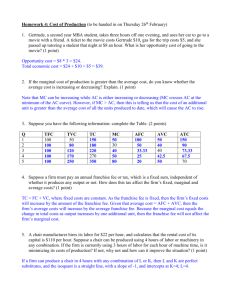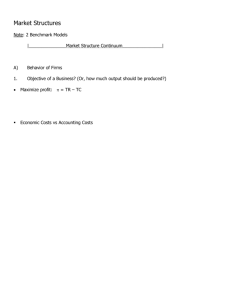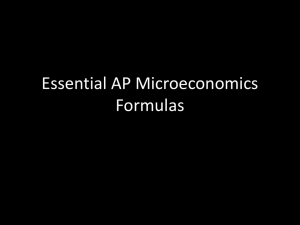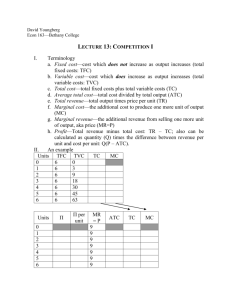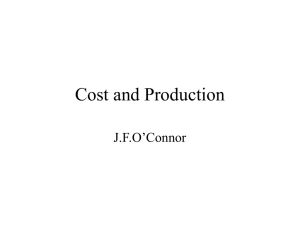ECN 1100 lec notes 6
advertisement
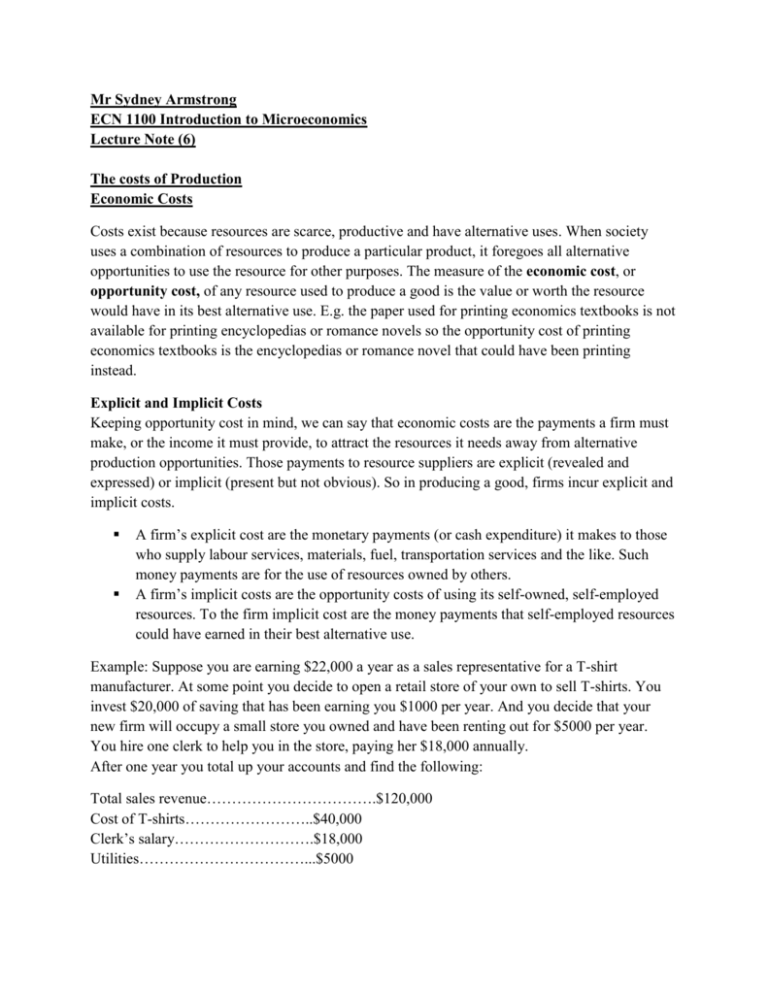
Mr Sydney Armstrong ECN 1100 Introduction to Microeconomics Lecture Note (6) The costs of Production Economic Costs Costs exist because resources are scarce, productive and have alternative uses. When society uses a combination of resources to produce a particular product, it foregoes all alternative opportunities to use the resource for other purposes. The measure of the economic cost, or opportunity cost, of any resource used to produce a good is the value or worth the resource would have in its best alternative use. E.g. the paper used for printing economics textbooks is not available for printing encyclopedias or romance novels so the opportunity cost of printing economics textbooks is the encyclopedias or romance novel that could have been printing instead. Explicit and Implicit Costs Keeping opportunity cost in mind, we can say that economic costs are the payments a firm must make, or the income it must provide, to attract the resources it needs away from alternative production opportunities. Those payments to resource suppliers are explicit (revealed and expressed) or implicit (present but not obvious). So in producing a good, firms incur explicit and implicit costs. A firm’s explicit cost are the monetary payments (or cash expenditure) it makes to those who supply labour services, materials, fuel, transportation services and the like. Such money payments are for the use of resources owned by others. A firm’s implicit costs are the opportunity costs of using its self-owned, self-employed resources. To the firm implicit cost are the money payments that self-employed resources could have earned in their best alternative use. Example: Suppose you are earning $22,000 a year as a sales representative for a T-shirt manufacturer. At some point you decide to open a retail store of your own to sell T-shirts. You invest $20,000 of saving that has been earning you $1000 per year. And you decide that your new firm will occupy a small store you owned and have been renting out for $5000 per year. You hire one clerk to help you in the store, paying her $18,000 annually. After one year you total up your accounts and find the following: Total sales revenue…………………………….$120,000 Cost of T-shirts……………………..$40,000 Clerk’s salary……………………….$18,000 Utilities……………………………...$5000 Total (explicit) costs……………………………..$63,000 Accounting profit………………………………...$57,000 Looks good. But unfortunately your accounting profits of $57,000 ignore your implicit costs and thus overstate the economic success of your venture. By providing your own financial capital, building and labour, you incur implicit cost (foregone incomes) of $1000 of interest, $5000 of rent and $22,000 of wages. If your entrepreneurial talent is worth, say, $5000 annually in other business endeavors of similar scope, you have also ignored that implicit cost. So: Accounting profit………………………………$57,000 Less foregone interest……………….$1,000 Less foregone rent…………………..$5,000 Less foregone wages………………..$22,000 Less foregone entrepreneurial income..$5,000 Total implicit costs…………………..$33,000 Economic profit…………………………………$24000 Economic Profit vs. Accounting Profit Obviously, then, economist use the term “profit” differently from the way accountants use it. To the accountant, profit is the firm’s total revenue less its explicit cost (or accounting cost). To the economist, economic profit is total revenue less economic costs (implicit and explicit cost). Therefore: Economic profit = Total revenue – economic cost (Explicit + Implicit) Accounting profit = Total revenue – explicit cost Short Run and Long Run When the demand for a firm’s product changes, the firm’s profitability may depend on how quickly it can adjust the amount of the various resources it employs. It can quickly adjust the quantities employed of many resources such as hourly labour, raw material, fuel and power. It needs much more time, however, to adjust its plant capacity - the size of the factory building, the amount of machinery and equipment and other capital resources. The short run is the period too brief for a firm to alter its plant capacity, yet long enough to permit a change in the degree to which the fixed plant is used. The firm’s plant capacity is fixed in the short run. However, the firm can vary its output by applying larger or smaller amount of labour, materials and other resources to that plant. It can use its existing plant capacity more or less intensively in the short run. In essence, in the short run some of the firm’s resources or at least one is fixed (the plant capacity) while the others are variable. The long run on the other hand is the period long enough for the firm to adjust the quantities of all the resources that it employs, including plant capacity. From the industry’s viewpoint, the long run also includes enough time for existing firms to dissolve and leave the industry or for new firms to be created and enter the industry. In essence in the long run there are no input or resource that is, all resources are variable. The short run and the long run are conceptual periods rather than calendar time periods. E.g. In light manufacturing industries, changes in plant capacity may be accomplished almost overnight. A small T-shirt manufacturer can increase its plant capacity in a matter of days by ordering and installing two or three new cutting tables and several extra sewing machines. But for heavy industry the long run is a different matter. Rubis may require several years to construct a new oil station in Guyana. Illustration of Long run and Short run adjustments If Boeing hires 100 extra workers for one of its commercial airline plants or adds an entire shift of workers, we are speaking of the short run. If it adds a new production facility and install more equipment, we are referring to the long run. Hence the first situation is a short run adjustment; the second is a long run adjustment. Short-Run Production Relationships A firm’s cost of producing a specific output depends on the prices of the needed resources and the quantity of resources (inputs) needed to produce that output. The study of production begins with understanding the production function. The production function is a technical specification of relating Inputs to output with a given state of technology. This can be mathematically represented by the equation that follows: Q= f(L,K) Where: Q is output produce L is labour used K is capital used Even though it is not stated Capital is held fixed in the short run and the state of technology. Before examining the short run relationships, we need to define three terms: Total product (TP) is the total quantity, or total output, of a particular good produced. Marginal Product (MP) is the extra product or added product associated with adding a unit of variable resource, in this case labour, to the production process. Thus Marginal product = Δ in total product / Δ labour input Average product (AP), also called labour productivity, is the output per unit of labour input: Average product = total product / units of labour In the short run, a firm can increase its output for a time by adding more units of labour to its fixed plant. But by how much will output rise when it adds the labour? Why do we say “for a time”? Units of Labour Total Production Marginal Product (MP) 0 1 2 3 4 5 6 7 8 0 10 25 45 60 70 75 75 70 10 15 20 15 10 5 0 -5 Average Product (AP) 10.0 12.5 15.0 15.0 14.0 12.5 10.7 8.8 The table above is an illustration of the relationship between Total product, Marginal product and Average product. Column shows the total product or total output, resulting from combining each level of a variable input (labour) in column 1 with a fixed amount of capital. Column 3 shows the marginal product (MP), the change in total product associated with each additional unit of labour. Note that with no labour input, total product is zero; a plant with no workers will produce no output. The first 3 units of labour reflects increasing marginal returns, with marginal product of 10, 15, 20 units, respectively. But beginning with the forth unit of labour, marginal product diminishes continuously, becoming zero with the seventh unit of labour and negative with the eighth. Note also that average product mirrors that of marginal product where the shape is concerned except that it remains positive throughout the analysis. This information can also be represented graphically. Total Production 80 70 60 50 40 Total Production 30 20 10 0 0 2 4 6 8 10 25 20 15 10 Marginal Product (MP) 5 Average Product (AP) 0 0 2 4 6 8 10 -5 -10 The graphs above further clarify the relationship between TP, MP and AP. Note in the first graph that TP goes through three phases: It rises initially at an increasing rate; then it increases, but at a diminishing rate; finally, after reaching a maximum, it declines. The MP curve is the slope of the TP curve. MP measures the change in TP associated with each succeeding unit of labour. Thus, the phases of TP are also reflected in MP. Where TP is increasing at an increasing rate, MP is rising. Here, extra unit of labour are adding larger and larger amounts of TP. Similarly, Where TP is increasing but at a decreasing rate, MP is positive but falling. In this case each additional unit of labour adds less to TP than did the previous unit. When TP is at maximum, MP is zero. When TP declines, MP becomes negative. Average product in graph 2 displays the same tendencies as marginal product. It increases, reaches a maximum and then decreases as more and more units of labour are added to the fixed plant. But note the relationship between MP and AP: When MP exceeds AP, AP is rising. And where MP is less than AP, AP is declining. Also it is important to note that MP always intersects AP when AP is at its Maximum. An important concept that is depicted by the short run production curves is the law of Diminishing Returns, also called the law of Diminishing Marginal Product. This law assumes that technology is fixed and thus the techniques of production do not change. It states that as successive units of a variable resource (say labour) are added to a fixed resource (say capital or land), beyond some point the extra, or marginal product that can be attributed to each additional unit of the variable resource will decline. In essence Diminishing marginal returns always step in when the marginal product declines. Short-Run Production Costs We know that in the short run some resources, those associated with the firm’s plant are fixed. Other resources, however, are variable. So short run costs are either fixed or variable. Fixed, Variable and Total costs Fixed Costs – Fixed costs (TFC) are those costs that in total do not vary with changes in output. Fixed costs are associated with the very existence of a firm’s plant and therefore must be paid even if its output is zero. Such costs as rental payments, interest on a firms debts, insurance premiums are generally fixe costs; they do not increase even if a firm produce more. By definition this fixed cost is incurred at all levels of output, including zero. The firm cannot avoid paying fixed costs in the short run. Variable Costs – Variable costs (TVC) are those costs that change with the level of output. They include payments for materials, fuel, power, transportation service, most labour and similar variable resources. Total Cost – Total cost (TC) is the sum of fixed cost and variable cost at each level of output. It is important to note also that at zero output, total cost equals to the firm’s fixed cost. Hence TC = TFC + TVC TFC = TC – TVC TVC = TC – TFC Total – Cost Data TP (Q) TFC TVC 0 $100 $ 0 1 100 90 2 100 170 3 100 240 4 100 300 5 100 370 6 100 450 7 100 540 8 100 650 9 100 780 10 100 930 TC $ 100 $ 190 $ 270 $ 340 $ 400 $ 470 $ 550 $ 640 $ 750 $ 880 $ 1030 Average – Cost Data AFC AVC ATC Marginal Cost MC This information can be shown graphically below: $1,200 $1,000 $800 TFC $600 TVC $400 TC $200 $0 ($200) 0 2 4 6 8 10 12 Read the following then complete the table. Per-Unit or Average costs Producers are certainly interested in their total costs, but they are equally concerned with pre-unit or average costs. In particular, average cost data are more meaningful for making comparisons with product price, which is always stated on a per-unit basis. The per-unit costs explore here are average fixed cost (AFC), average variable cost (AVC) and average total cost (ATC or AC). AFC – Average fixed cost foe any output level is found by dividing total fixed cost (TFC) by output (Q). That is, AFC = TFC / Q. Because the total fixed cost is, by definition, the same regardless of output, AFC will decline as output increases (this can be seen from the table which you suppose to complete). As output rises, the total fixed is spread over a larger and larger output. This process is sometimes referred to as “spreading the overhead”. The graph below shows AFC continuously declining as total output is increased. AVC – Average variable cost for any output level is calculated by dividing total variable cost (TVC) by that output (Q). That is, AVC = TVC / Q. As added variable resources increase output, AVC declines initially, reaches a minimum and then increases again. What this mean is that at a very low levels of output, production is relatively inefficient and costly. Because the firm fixed plant is understaffed, average variable cost is relatively high. As output expands, however, greater specialization and better use of the firm’s capital equipment yield more efficiency and variable cost per unit of output declines. As still more variable resources are added, a point is reached where diminishing returns are incurred. The firm’s capital equipment is now staffed more intensively and therefore each added input unit does not increase output by as much as preceding inputs. This means that the AVC eventually increases. The graph of AVC is U-shaped or saucer-shaped curve. ATC – Average total cost for any output level is found by dividing total cost (TC) by that output (Q) or by adding AFC and AVC at that output: ATC = TC / Q = TFC/Q + TVC/Q = AFC + AVC. It is important to note that the vertical difference between ATC and AVC curves measures AFC at any level of output. The graph of ATC is also U-shaped or saucer-shaped curve. Marginal Cost One final and very crucial cost concept remains: Marginal cost (MC) is the extra, or additional, cost of producing one more unit of output. MC can be determined for each added unit of output by noting the change in total cost which that unit’s production entails: MC = Δ in TC / Δ in Q. The graph of MC is also U-shaped or saucer-shaped curve. Graphical Portrayal $200.0 $180.0 $160.0 $140.0 $120.0 $100.0 $80.0 $60.0 $40.0 $20.0 $0.0 AVC AVC ATC MC - 0 2 4 6 8 10 12 Relationship among MC, AVC and ATC There are three important relationships between MC, AVC and ATC. 1) Marginal cost always cuts AVC and ATC at their minimum point 2) When MC is below AVC and ATC, AVC and ATC would be falling as more output is produced. 3) When MC is above AVC and ATC, AVC and AVC would be rising as more output is produced. The notes came from McConnell &Brue, Economics, 15th edition, 2002. You are required to supplement this with additional reading.

